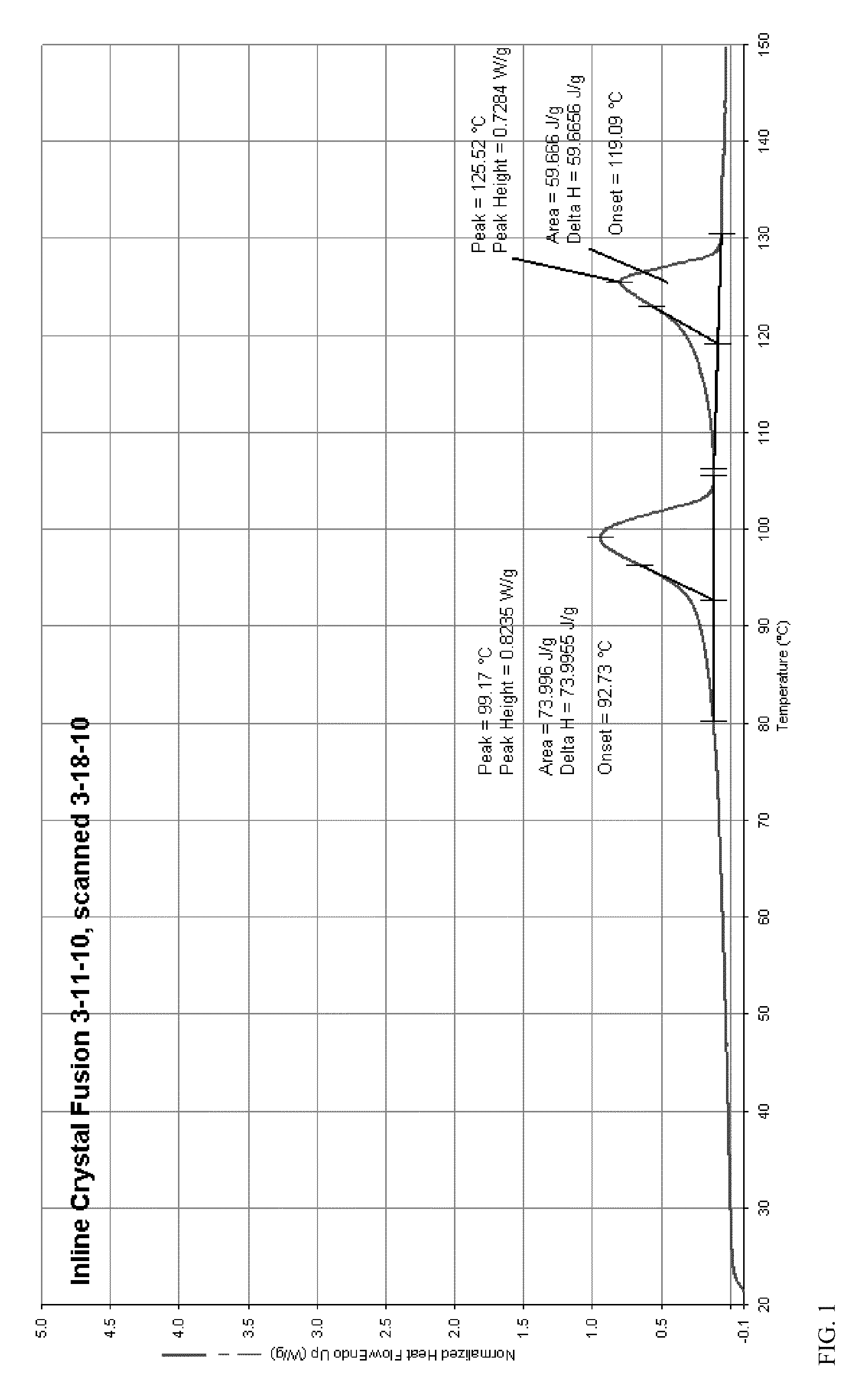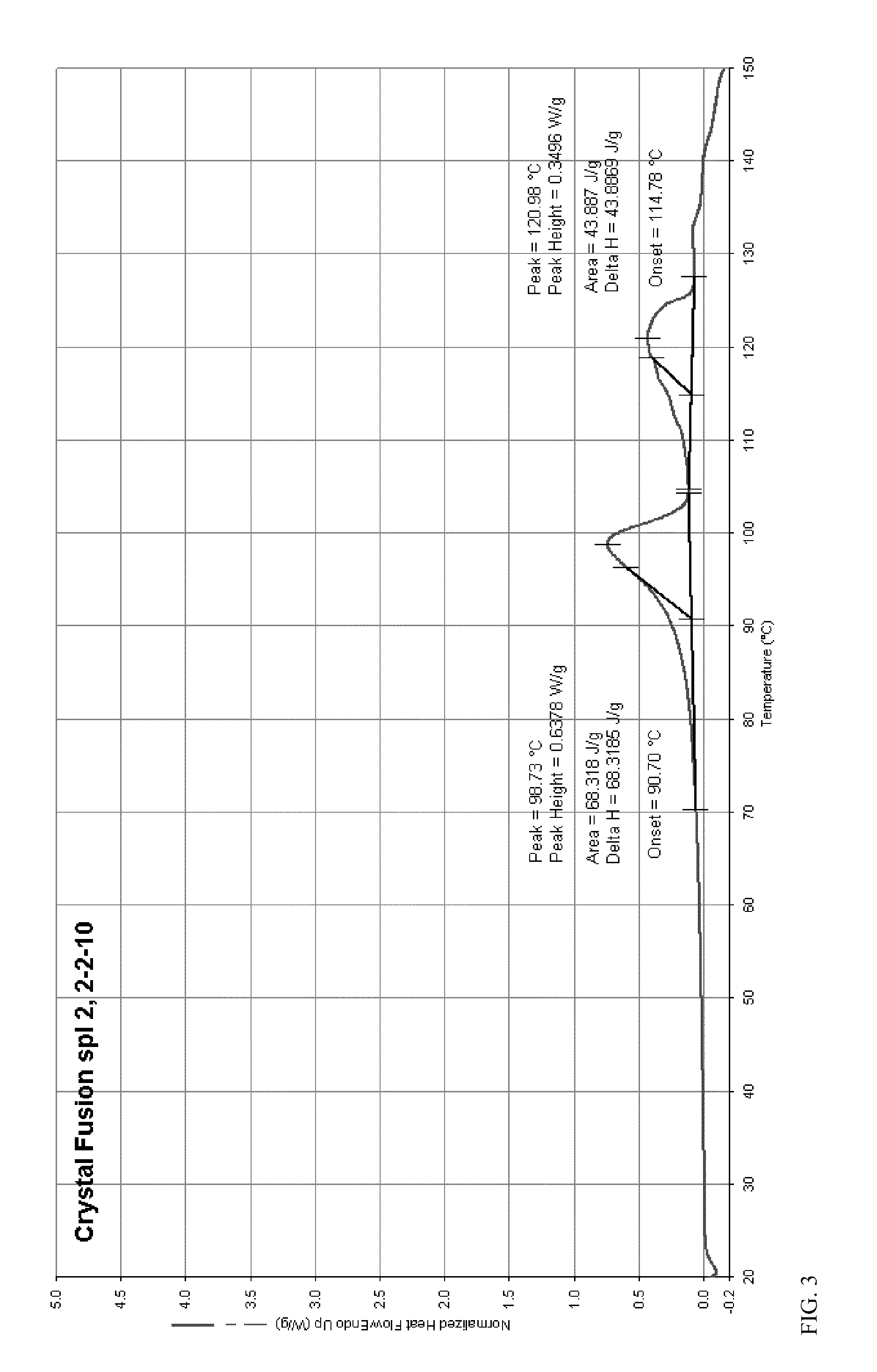Enhanced melting point rinse aid solids
a technology of rinse water and solids, which is applied in the direction of tableware washing/rinsing machine details, foam regulating compositions, detergent compounding agents, etc., can solve the problems of reducing the service life of the rinse water, affecting the cleaning effect, so as to reduce the filming of water solids in the rinse water, and reduce the filming of water solids
- Summary
- Abstract
- Description
- Claims
- Application Information
AI Technical Summary
Benefits of technology
Problems solved by technology
Method used
Image
Examples
examples 1 through 5
Solid Rinse Aid Compositions Prepared According to the Invention
[0155]A liquid premix was prepared according to the composition in the following table:
Premix:
[0156]
ComponentPercent by weightNovel II 1012GB21a22.7Pluronic 25R2b22.7Kathonc1.4HCl0.1Water2.74Blue #1 dye0.19Yellow #5 dye0.015ABILd2.54aethoxylated alcohol surfactant available from Sasolbalcohol ethoxylate surfactant available from BASFcblend of methylchloroisothiazolinone and methylisothiazolinone available from Rohm and Haasddimethicone propyl PG-Betaine, 30%, available from available from Degussa
The Sassol and Pluronic 25R2 were combined. Kathon was added to the combination and the pH was checked. A 10 weight percent solution in water has a target pH of between 5 and 7. The pH was adjusted down with HCl and adjusted up as needed with NaOH using 10-20 gram increments. The water and dyes were added after pH adjustment was complete. Finally, the ABIL surfactant was added immediately before running.
[0157]Five different rins...
example 6
Solid Rinse Aid Compositions
[0160]Each of the formulations, A through F, according to the present invention includes the combination Sodium Sulfate and urea for solid formation with defoamer (Polyoxypropylene polyoxyethylene Block copolymer) and a sheeting agent (solid alcohol ethoxylates), as well as sufficient acid (sorbic, benzoic and sodium bisulfate) acting as effective preservative. Example formulas D and F are also GRAS and biodegradable. In contrast, the conventional solid rinse aid uses propylene glycol and urea at lower water content water for solidification.
FormulationConventionalIngredientsABCDEFSolid Rinse AidWater12.5012.5012.5012.5012.50 12.503.29alcohol ethoxylates20.1120.1120.1120.1127.37 27.37—Polyoxypropylene14.0814.0814.08—19.16 —64.62 polyoxyethylene Blockcopolymer (LDO-97)Polyoxypropylene5.675.675.67—8.21—9.00polyoxyethylene Blockcopolymer (DO-97)polydimethyl1.211.211.211.21———siloxones (30%)Polyoxypropylene———23.44—27.37—polyoxyethylene Blockcopolymer (Plurafa...
example 7
Stable Form Formation Assessment
[0165]In this example, a series of tests were run to compare the foam profiles of several of the raw materials (i.e. sheeting agents and defoamers) by themselves, in certain combinations with each other, and in combination with selected solid rinse aids of the present invention as well as a conventional solid rinse aid. The formulations are provided in Example 6. The foam level and foam stability was read after one minute of agitation and again after 5 minutes of agitation. This test was done at 140° F. under 6 atmospheres of pressure in a Glewwe Foam Testing Machine, with 50 ppm of active agent added, at an Ecolab Inc. facility. Stable foam was defined as foam that remains for several minutes after agitation is stopped. Partially stable foam was defined as foam that breaks slowly within a minute. Unstable foam was defined by foam that breaks rapidly (i.e., breaks in less than 15 seconds). The results of the tests are shown in the following table.
Glew...
PUM
 Login to View More
Login to View More Abstract
Description
Claims
Application Information
 Login to View More
Login to View More - R&D
- Intellectual Property
- Life Sciences
- Materials
- Tech Scout
- Unparalleled Data Quality
- Higher Quality Content
- 60% Fewer Hallucinations
Browse by: Latest US Patents, China's latest patents, Technical Efficacy Thesaurus, Application Domain, Technology Topic, Popular Technical Reports.
© 2025 PatSnap. All rights reserved.Legal|Privacy policy|Modern Slavery Act Transparency Statement|Sitemap|About US| Contact US: help@patsnap.com



